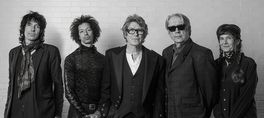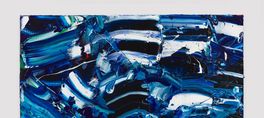Fraenkel Gallery is pleased to present Hiroshi Sugimoto: Opticks, an exhibition of new large-scale photographs on view for the first time in the U.S. The images depict the color of light Sugimoto observed through a prism in his Tokyo studio. Using Polaroid film, he recorded sections of the rainbow spectrum projected into a darkened chamber, paying particular attention to the spaces and gaps between hues. The resulting works, each measuring approximately 5' framed, are vivid, near-sculptural renderings of pure light. The exhibition will be on view from March 26 to June 20, 2020.
Sugimoto describes his process, which began before sunrise and depended on the clarity of the winter light: "First thing, I would check for hints of light dawning above the eastern horizon. If the day promised fair weather, next I would sight the 'morning star' shining to the upper right of the nascent dawn. Depending on how bright Venus appeared, I could judge the clarity of the air that day--Tokyo is clear almost every day in winter thanks to the prevailing seasonal west-high east-low pressure patterns. Only then did I ready my old Polaroid camera and start warming up a film pack from the long winter night chill," he writes. In his studio, he used a mirror outfitted with a special micro-adjusting tilting mechanism, and projected light from the prism onto the mirror. By adjusting the mirror's angle, he could separate individual colors of light. "I could split red into an infinity of reds," he explains.
In his work, Hiroshi Sugimoto has explored the ways photography can be used to record traces of invisible but elemental forces. His philosophical approach asks questions about the human experience of these phenomena. Inspired by the writings and research of Sir Isaac Newton and Johann Wolfgang von Goethe on the science and experience of light, the works in Opticks examine the infinite nature and dual status of color as a physical phenomena and an emotional force. Sugimoto titled Opticks after Newton's 1704 book of the same name, which presented his groundbreaking experiments with prisms and light. More than 100 years later, in 1810, Goethe published Zur Farbenlehre (Theory of Colors), a study of the physical basis of colors and human responses to them, which found Newton's "impersonal scientific exposition wanting on artistic grounds," Sugimoto writes.
Looking at light through his own prism, he notes:
I too had my doubts about Newton's seven-colour spectrum: yes, I could see his red-orange-yellow-green-blue-indigo-violet schema, but I could just as easily discern many more different colours in-between, nameless hues of red-to-orange and yellow-to-green. Why must science always cut up the whole into little pieces when it identifies specific attributes? The world is filled with countless colours, so why did natural science insist on just seven? I seem to get a truer sense of the world from those disregarded intracolours. Does not art serve to retrieve what falls through the cracks, now that scientific knowledge no longer needs a God?
The exhibition will also include a sculptural rendering of a mathematical model from Sugimoto's series of conceptual forms, along with work from other series.
Hiroshi Sugimoto was born in Japan in 1948. Starting in the 1970s, he worked primarily in photography, eventually adding performing arts production and architecture to his multidisciplinary practice. His work investigates themes of time, empiricism and metaphysics. Sugimoto's work is held in the collections of the Metropolitan Museum of Art, New York; Museum of Modern Art, New York; National Gallery of Art, Washington, DC; San Francisco Museum of Modern Art; and Tate Gallery, London; among many others. His work has been the subject of numerous monographs. In 2017, he founded the Odawara Art Foundation, dedicated to traditional Japanese and international contemporary performing arts. Sugimoto is the recipient of the National Arts Club Medal of Honor in Photography; The Royal Photographic Society's Centenary Medal; Isamu Noguchi Award; Officier de L'ordre des Arts et des Lettres; Praemium Imperiale Award for Painting; PHotoEspaña Prize; and the Hasselblad Foundation International Award in Photography, among others.
show less
Sugimoto describes his process, which began before sunrise and depended on the clarity of the winter light: "First thing, I would check for hints of light dawning above the eastern horizon. If the day promised fair weather, next I would sight the 'morning star' shining to the upper right of the nascent dawn. Depending on how bright Venus appeared, I could judge the clarity of the air that day--Tokyo is clear almost every day in winter thanks to the prevailing seasonal west-high east-low pressure patterns. Only then did I ready my old Polaroid camera and start warming up a film pack from the long winter night chill," he writes. In his studio, he used a mirror outfitted with a special micro-adjusting tilting mechanism, and projected light from the prism onto the mirror. By adjusting the mirror's angle, he could separate individual colors of light. "I could split red into an infinity of reds," he explains.
In his work, Hiroshi Sugimoto has explored the ways photography can be used to record traces of invisible but elemental forces. His philosophical approach asks questions about the human experience of these phenomena. Inspired by the writings and research of Sir Isaac Newton and Johann Wolfgang von Goethe on the science and experience of light, the works in Opticks examine the infinite nature and dual status of color as a physical phenomena and an emotional force. Sugimoto titled Opticks after Newton's 1704 book of the same name, which presented his groundbreaking experiments with prisms and light. More than 100 years later, in 1810, Goethe published Zur Farbenlehre (Theory of Colors), a study of the physical basis of colors and human responses to them, which found Newton's "impersonal scientific exposition wanting on artistic grounds," Sugimoto writes.
Looking at light through his own prism, he notes:
I too had my doubts about Newton's seven-colour spectrum: yes, I could see his red-orange-yellow-green-blue-indigo-violet schema, but I could just as easily discern many more different colours in-between, nameless hues of red-to-orange and yellow-to-green. Why must science always cut up the whole into little pieces when it identifies specific attributes? The world is filled with countless colours, so why did natural science insist on just seven? I seem to get a truer sense of the world from those disregarded intracolours. Does not art serve to retrieve what falls through the cracks, now that scientific knowledge no longer needs a God?
The exhibition will also include a sculptural rendering of a mathematical model from Sugimoto's series of conceptual forms, along with work from other series.
Hiroshi Sugimoto was born in Japan in 1948. Starting in the 1970s, he worked primarily in photography, eventually adding performing arts production and architecture to his multidisciplinary practice. His work investigates themes of time, empiricism and metaphysics. Sugimoto's work is held in the collections of the Metropolitan Museum of Art, New York; Museum of Modern Art, New York; National Gallery of Art, Washington, DC; San Francisco Museum of Modern Art; and Tate Gallery, London; among many others. His work has been the subject of numerous monographs. In 2017, he founded the Odawara Art Foundation, dedicated to traditional Japanese and international contemporary performing arts. Sugimoto is the recipient of the National Arts Club Medal of Honor in Photography; The Royal Photographic Society's Centenary Medal; Isamu Noguchi Award; Officier de L'ordre des Arts et des Lettres; Praemium Imperiale Award for Painting; PHotoEspaña Prize; and the Hasselblad Foundation International Award in Photography, among others.
Fraenkel Gallery is pleased to present Hiroshi Sugimoto: Opticks, an exhibition of new large-scale photographs on view for the first time in the U.S. The images depict the color of light Sugimoto observed through a prism in his Tokyo studio. Using Polaroid film, he recorded sections of the rainbow spectrum projected into a darkened chamber, paying particular attention to the spaces and gaps between hues. The resulting works, each measuring approximately 5' framed, are vivid, near-sculptural renderings of pure light. The exhibition will be on view from March 26 to June 20, 2020.
Sugimoto describes his process, which began before sunrise and depended on the clarity of the winter light: "First thing, I would check for hints of light dawning above the eastern horizon. If the day promised fair weather, next I would sight the 'morning star' shining to the upper right of the nascent dawn. Depending on how bright Venus appeared, I could judge the clarity of the air that day--Tokyo is clear almost every day in winter thanks to the prevailing seasonal west-high east-low pressure patterns. Only then did I ready my old Polaroid camera and start warming up a film pack from the long winter night chill," he writes. In his studio, he used a mirror outfitted with a special micro-adjusting tilting mechanism, and projected light from the prism onto the mirror. By adjusting the mirror's angle, he could separate individual colors of light. "I could split red into an infinity of reds," he explains.
In his work, Hiroshi Sugimoto has explored the ways photography can be used to record traces of invisible but elemental forces. His philosophical approach asks questions about the human experience of these phenomena. Inspired by the writings and research of Sir Isaac Newton and Johann Wolfgang von Goethe on the science and experience of light, the works in Opticks examine the infinite nature and dual status of color as a physical phenomena and an emotional force. Sugimoto titled Opticks after Newton's 1704 book of the same name, which presented his groundbreaking experiments with prisms and light. More than 100 years later, in 1810, Goethe published Zur Farbenlehre (Theory of Colors), a study of the physical basis of colors and human responses to them, which found Newton's "impersonal scientific exposition wanting on artistic grounds," Sugimoto writes.
Looking at light through his own prism, he notes:
I too had my doubts about Newton's seven-colour spectrum: yes, I could see his red-orange-yellow-green-blue-indigo-violet schema, but I could just as easily discern many more different colours in-between, nameless hues of red-to-orange and yellow-to-green. Why must science always cut up the whole into little pieces when it identifies specific attributes? The world is filled with countless colours, so why did natural science insist on just seven? I seem to get a truer sense of the world from those disregarded intracolours. Does not art serve to retrieve what falls through the cracks, now that scientific knowledge no longer needs a God?
The exhibition will also include a sculptural rendering of a mathematical model from Sugimoto's series of conceptual forms, along with work from other series.
Hiroshi Sugimoto was born in Japan in 1948. Starting in the 1970s, he worked primarily in photography, eventually adding performing arts production and architecture to his multidisciplinary practice. His work investigates themes of time, empiricism and metaphysics. Sugimoto's work is held in the collections of the Metropolitan Museum of Art, New York; Museum of Modern Art, New York; National Gallery of Art, Washington, DC; San Francisco Museum of Modern Art; and Tate Gallery, London; among many others. His work has been the subject of numerous monographs. In 2017, he founded the Odawara Art Foundation, dedicated to traditional Japanese and international contemporary performing arts. Sugimoto is the recipient of the National Arts Club Medal of Honor in Photography; The Royal Photographic Society's Centenary Medal; Isamu Noguchi Award; Officier de L'ordre des Arts et des Lettres; Praemium Imperiale Award for Painting; PHotoEspaña Prize; and the Hasselblad Foundation International Award in Photography, among others.
read more
Sugimoto describes his process, which began before sunrise and depended on the clarity of the winter light: "First thing, I would check for hints of light dawning above the eastern horizon. If the day promised fair weather, next I would sight the 'morning star' shining to the upper right of the nascent dawn. Depending on how bright Venus appeared, I could judge the clarity of the air that day--Tokyo is clear almost every day in winter thanks to the prevailing seasonal west-high east-low pressure patterns. Only then did I ready my old Polaroid camera and start warming up a film pack from the long winter night chill," he writes. In his studio, he used a mirror outfitted with a special micro-adjusting tilting mechanism, and projected light from the prism onto the mirror. By adjusting the mirror's angle, he could separate individual colors of light. "I could split red into an infinity of reds," he explains.
In his work, Hiroshi Sugimoto has explored the ways photography can be used to record traces of invisible but elemental forces. His philosophical approach asks questions about the human experience of these phenomena. Inspired by the writings and research of Sir Isaac Newton and Johann Wolfgang von Goethe on the science and experience of light, the works in Opticks examine the infinite nature and dual status of color as a physical phenomena and an emotional force. Sugimoto titled Opticks after Newton's 1704 book of the same name, which presented his groundbreaking experiments with prisms and light. More than 100 years later, in 1810, Goethe published Zur Farbenlehre (Theory of Colors), a study of the physical basis of colors and human responses to them, which found Newton's "impersonal scientific exposition wanting on artistic grounds," Sugimoto writes.
Looking at light through his own prism, he notes:
I too had my doubts about Newton's seven-colour spectrum: yes, I could see his red-orange-yellow-green-blue-indigo-violet schema, but I could just as easily discern many more different colours in-between, nameless hues of red-to-orange and yellow-to-green. Why must science always cut up the whole into little pieces when it identifies specific attributes? The world is filled with countless colours, so why did natural science insist on just seven? I seem to get a truer sense of the world from those disregarded intracolours. Does not art serve to retrieve what falls through the cracks, now that scientific knowledge no longer needs a God?
The exhibition will also include a sculptural rendering of a mathematical model from Sugimoto's series of conceptual forms, along with work from other series.
Hiroshi Sugimoto was born in Japan in 1948. Starting in the 1970s, he worked primarily in photography, eventually adding performing arts production and architecture to his multidisciplinary practice. His work investigates themes of time, empiricism and metaphysics. Sugimoto's work is held in the collections of the Metropolitan Museum of Art, New York; Museum of Modern Art, New York; National Gallery of Art, Washington, DC; San Francisco Museum of Modern Art; and Tate Gallery, London; among many others. His work has been the subject of numerous monographs. In 2017, he founded the Odawara Art Foundation, dedicated to traditional Japanese and international contemporary performing arts. Sugimoto is the recipient of the National Arts Club Medal of Honor in Photography; The Royal Photographic Society's Centenary Medal; Isamu Noguchi Award; Officier de L'ordre des Arts et des Lettres; Praemium Imperiale Award for Painting; PHotoEspaña Prize; and the Hasselblad Foundation International Award in Photography, among others.
show less
Date/Times:
49 Geary Street, 4th Floor, San Francisco, CA 94108
The Best Events
Every Week in Your Inbox
From Our Sponsors
UPCOMING EVENTS
Great suggestion! We'll be in touch.
Event reviewed successfully.









